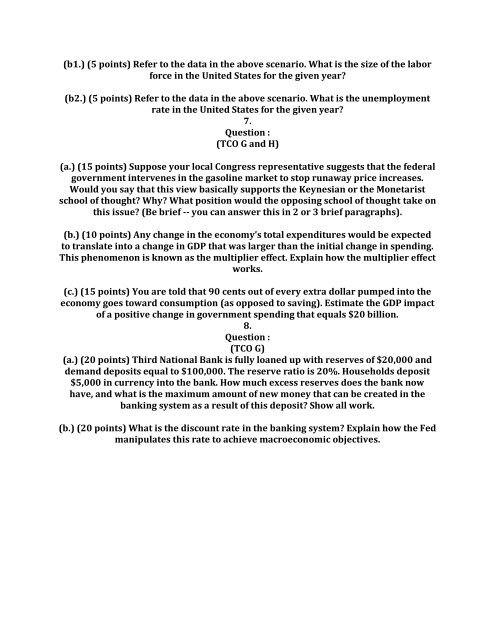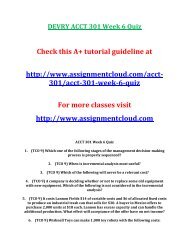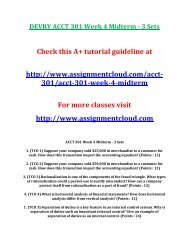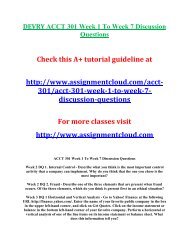UOP ECON 545 Week 8 Final Exam
econ/545 week 8,devry econ 545 week 8 dq 1,econ 545 week 8 dq 2,econ/545,devry econ/545,devry econ 545 week 8 final exam,econ 545 entire course,econ 545 final help
econ/545 week 8,devry econ 545 week 8 dq 1,econ 545 week 8 dq 2,econ/545,devry econ/545,devry econ 545 week 8 final exam,econ 545 entire course,econ 545 final help
Create successful ePaper yourself
Turn your PDF publications into a flip-book with our unique Google optimized e-Paper software.
(b1.) (5 points) Refer to the data in the above scenario. What is the size of the labor<br />
force in the United States for the given year?<br />
(b2.) (5 points) Refer to the data in the above scenario. What is the unemployment<br />
rate in the United States for the given year?<br />
7.<br />
Question :<br />
(TCO G and H)<br />
(a.) (15 points) Suppose your local Congress representative suggests that the federal<br />
government intervenes in the gasoline market to stop runaway price increases.<br />
Would you say that this view basically supports the Keynesian or the Monetarist<br />
school of thought? Why? What position would the opposing school of thought take on<br />
this issue? (Be brief -- you can answer this in 2 or 3 brief paragraphs).<br />
(b.) (10 points) Any change in the economy’s total expenditures would be expected<br />
to translate into a change in GDP that was larger than the initial change in spending.<br />
This phenomenon is known as the multiplier effect. Explain how the multiplier effect<br />
works.<br />
(c.) (15 points) You are told that 90 cents out of every extra dollar pumped into the<br />
economy goes toward consumption (as opposed to saving). Estimate the GDP impact<br />
of a positive change in government spending that equals $20 billion.<br />
8.<br />
Question :<br />
(TCO G)<br />
(a.) (20 points) Third National Bank is fully loaned up with reserves of $20,000 and<br />
demand deposits equal to $100,000. The reserve ratio is 20%. Households deposit<br />
$5,000 in currency into the bank. How much excess reserves does the bank now<br />
have, and what is the maximum amount of new money that can be created in the<br />
banking system as a result of this deposit? Show all work.<br />
(b.) (20 points) What is the discount rate in the banking system? Explain how the Fed<br />
manipulates this rate to achieve macroeconomic objectives.

















